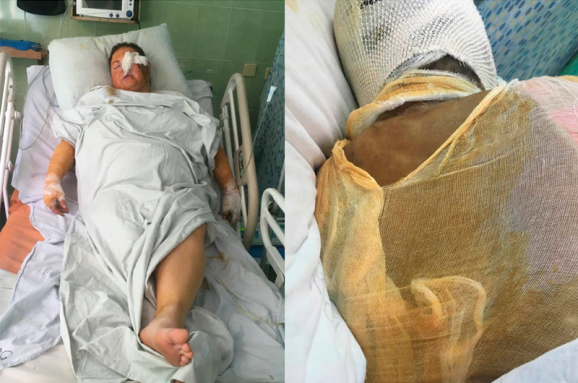Kateryna Handziuk had just come out of her apartment when an unknown attacker splashed a litre of sulfuric acid into her face and ran away. Passers-by rushed to wash the volatile smoking liquid off her body and get her to the hospital. More than 30% of Kateryna’s body is now covered in burns; the acid got into her eyes and her vision is impaired.
This could read like one of India’s acid “honor” attacks on women if it didn’t happen in the South-Ukrainian city of Kherson and if Kateryna hadn’t made dealing with corruption and local pro-Russian separatists – including among the law enforcement structures - her life vocation.
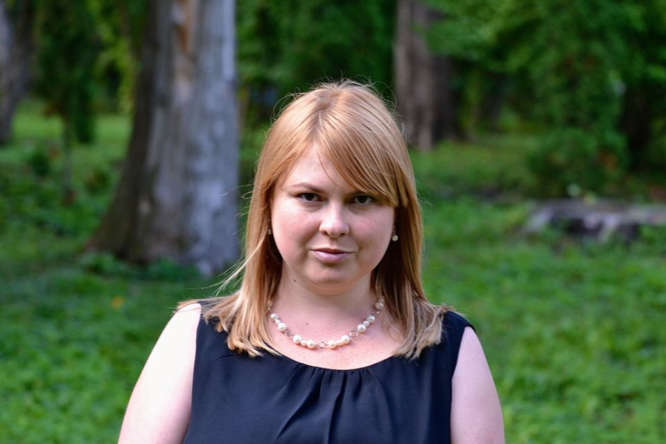
The sharp-tongued Handziuk, being an official of the city council and advisor to the mayor, is more frequently described as an “activist,” as she is known for her active pro-Ukrainian stance and policy of intolerance to local pro-Russian separatists, representatives of corruption clans and officials who she suspected in illegal gains.
“Kateryna Handziuk […] did a lot to make sure that many of the police officers with pro-Russian views and a corruption background did not become part of the new management of the National Police. […] Basically, thanks to such people as Kateryna, the ‘Russian spring’ of 2014 didn’t come to the Ukrainian south, as it came to Donbas and Crimea,” Ukrainian MP and former adviser to the Head of the SBU Yuriy Mykhalchyshyn told ZIK, referring to Russia’s ultimately unsuccessful attempts to break off south-eastern Ukraine in 2014, following the Euromaidan revolution and Russian occupation of Crimea.
The Russian-backed Luhansk and Donetsk “People’s Republics” in eastern Ukraine is the practical outcome of this project; however, Russian activities to destabilize Ukraine continue to this day.
Perhaps one of Handziuk’s most well-known conflicts is that with Artem Antoshchuk from the local Kherson police department of economic security, whom Handziuk accused of demands to extort 3% of the city’s budget for procurements.
This could explain why the police were suspiciously inactive in investigating her case in the first few days after the incident happened on 31 July. Initially qualifying the crime as “hooliganism” and not attempt at murder, the police failed to quickly gather footage from CTV cameras and question witnesses, despite the latter proposing to speak themselves. This led Kateryna’s colleagues and friends to undertake a series of public actions to pressure the authorities to act in what has been aptly dubbed “butt-kicking democracy.”
Protests, calls to the authorities, articles, official inquiries, and even international appeals by Transparency International and the US Embassy to Ukraine, appear to have brought results: Handziuk has been transported to Kyiv for treatment at the central burn center, and the National Police deputy chief Viacheslav Abroskin announcing on the evening of 3 August that a suspect had been detained.
“Activism in their blood”
It remains to be seen whether Ukrainian law enforcement will be able to find the attacker. What is undeniable at the moment is that the attack on Handziuk is the latest in a string of attacks on activists, many of whom are from Ukraine’s South-East. It is there that a revanche of the old corruption feudal clans associated with Viktor Yanukovych, the pro-Russian ex-president who fled Ukraine amid the Euromaidan revolution in February 2014, is being prophesized.
As journalist Khrystyna Berdynskykh puts it, after Euromaidan, the number of corruption fighters and active citizens increased in the regions. However, they are facing a formidable force. Usually, an influential local oligarch, state official, or politician considers himself the “king” of the oblast or city. He knows how to negotiate with the new and old elites in order to divide the zones of influence, how to approach the local councils, has good relations with the local prosecutors and police, despite these institutions being tasked with investigating the activity of such “kings.” And the worst case is when these “kings” work in the law enforcement structures.
Life for these kings is still looking good four years after Ukraine’s “Revolution of dignity,” but sometimes civic activists, journalists, or people with an active civic position get on their nerves. They come to investigate something, make inquiries, hold protests. The names of these local heroes are usually unknown to the stronger civic activity community in Kyiv, but their addresses and daily routines are well known to the “kings.” And that can be fatal.
Journalist Volodymyr Semkiv rates the wave of attacks on activists in Ukraine approximately at the same level as during the times of Euromaidan, when hired thugs beat up, sometimes fatally, journalists and activists. More often than not, these attacks face police inaction and the hitmen and masterminds are seldom brought to justice.
Here are some of the most egregious cases, courtesy of zbruc.eu
.
South Ukraine, Kherson
News of the attack on Kateryna Handziuk spread through the Facebook post of Kherson journalist and representative of the Chesno electoral monitoring organization Serhiy Nikitenko. But one month ago, on 18 June, he was the victim of an attack himself: two men beat him up on the street and ran away. The police are beating around the bush with the investigation, claiming that Nikitenko had not proven he is a journalist. Commenting on the attack on her friend, Kateryna Handziuk wrote that the “final mastermind” of all the attacks is “all the same” – pro-Russian forces:
“All these events are NOT investigated by the police. Believe me, we have enough experience in the civic-political sector to know this for sure. But what irks me the most is that the cops openly laugh at us and in their circles openly regret that the activists hadn’t received enough,” she laments.
South Ukraine, Odesa
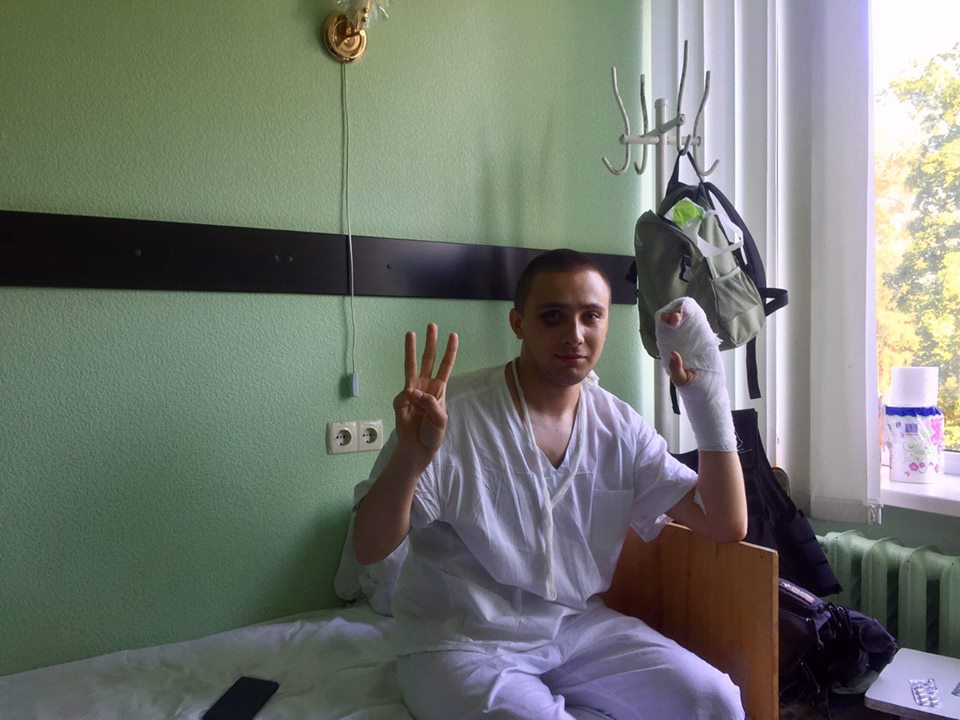
Serhiy Sternenko, an activist and former member of the far-right Right Sector organization in the city of Odesa, has been attacked three times in the last year. Odesa, a hotspot of separatism during Russia’s attempts to break off South-Eastern Ukraine in the wake of the Euromaidan revolution in 2014, remains a target for Russian attempts to destabilize Ukraine. Sternenko’s activism is diverse and controversial, involving resistance to pro-Russian separatist activities in 2014, fighting corruption clans, blockading occupied Crimea, boycotting concerts of Russian and pro-Russian artists, and resisting illegal construction in the city park. Despite Serhiy’s appeals for police protection, none was given and in the last attack on 25 May 2018, Sternenko killed the attacker. Now he may be prosecuted himself.
Commenting on Handziuk’s attack, Sternenko stated that “attacks and murder of people with an active civic position have long become an unhealthy tendency.” According to him, police inactivity in investigating and prosecuting the perpetrators is what allows these attacks to happen. As to the mastermind of the attacks, Sternenko thinks that a structure with staff and money is behind them, and that
“right now, the Russians and local feudal lords controlled by them have the most money. […] If the top management of the country maintains their silence and indifference in this matter, there will be a lot of blood.”
Another Odesa activist, Automaidan leader Vitaliy Ustymenko
(above) was attacked on 5 June in the middle of the day. He was hospitalized with a stab in his thigh and head traumas. Ustymenko is known as one of the chief organizers of resistance to the “Russian spring” in 2014 and afterwards became an anti-corruption and urban activist fighting against illegal construction, as well as the personal enemy of notoriously corrupt Odesa mayor Hennadiy Trukhanov. He notes that the recent physical pressure on activists has taken a toll on their effectiveness.
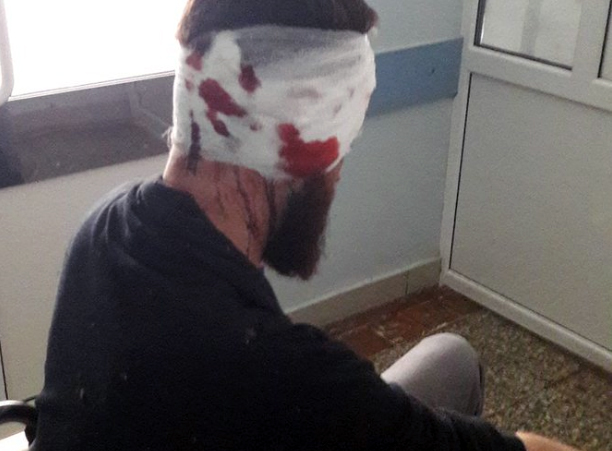
In 2017, two attacks on representatives of the Kharkiv anti-corruption center took place: Dmytro Bulakh was attacked in August and Yevhen Lisichkin – in September. Bulakh has hospitalized with head trauma and broken ribs. This investigation has gone forward, with the police reporting that they detained a group of people who apart from the attacks committed a number of other crimes, including extortions and blowing up a chain of pharmacies. However, the mastermind has not been identified.
Kyiv, the capital
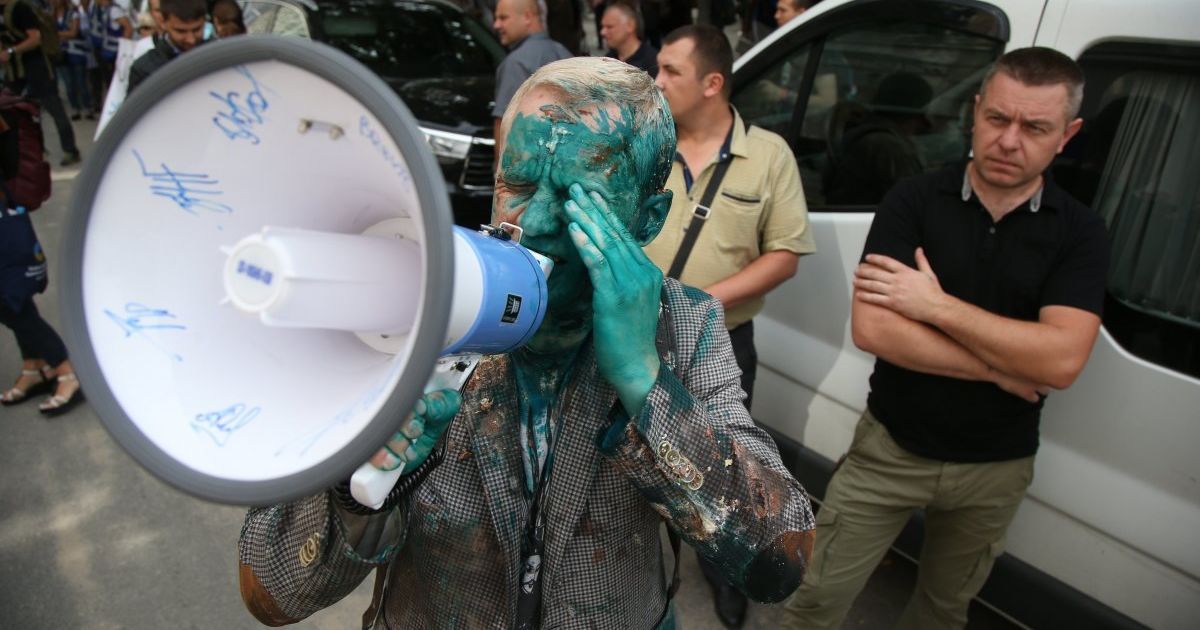
Vitaliy Shabunin, Head of the Anti-Corruption Action Center (AntAC), fell victim to an attack in Kyiv on 18 July 2018 during a protest near the Special Anticorruption Prosecutor’s (SAP) Office. A group of persons in sportswear and military uniforms spilt a bottle of the brilliant green antiseptic into his eyes, causing a chemical burn. The attackers played on the side of SAP head Nazar Kholodnytskyi and Minister of Interior Arsen Avakov. In those days, Kholodnytskyi closed several proceedings against Avakov allies.
AntAC with the help of social media users identified most of the attackers with the help of a “collective investigation.”
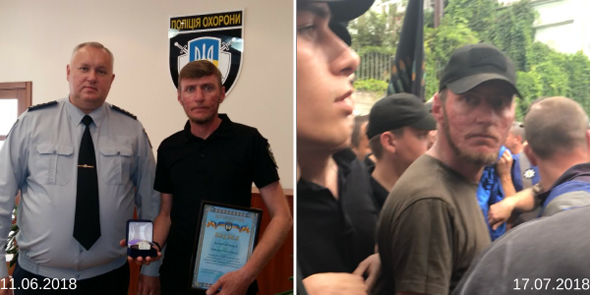
The activists managed to trace the attackers to the far-right “Bratstvo” led by Dmytro Korchynskyi and Illia Kiva, Socialist Party leader and advisor to Minister of Interior Arsen Avakov.
As well, they identified that a part of the attackers had served in the structure of the Interior Ministry.
“Why are we not sure that those guilty of attacks on activists will be brought to justice? Because often the attackers and subordinates of Minister Avakov are on the same side of the barricades,” AntAC wrote after the attack on Kateryna Handziuk.
“Close connections” between the police and the criminal underworld
These attacks are only five of the 18 attacks on journalists, activists, and bloggers in Ukraine after 2016, which Kyiv journalist and member of the Media Initiative for Human Rights Olga Reshetylova listed inviting her readers to a rally to demand justice for Handziuk near the Ministry of Interior on 1 August. Reshetylova claims that none of these cases has been effectively investigated by the law enforcement agencies and brought to court.
The geography of attacks covers mostly south-eastern Ukraine and is diverse, including:
- the murder of Belarusian-Ukrainian journalist Pavlo Sheremet in Kyiv;
- attacks of activists and journalists by the security of a local MP in Toretsk (Donetsk Oblast) and the arson of an activist’s car in the same city;
- attacks on Alina Radchenko and Svitlana Pidpala, two activists in Odesa;
- the murder of Serhiy Samarskyi, a pro-Ukrainian civic activist in Sievierodonetsk (Luhansk Oblast);
- the murder of Kyiv lawyer Iryna Nozdrovska;
- the beating of local civic activist Serhiy Mokrousov in Kryvyi Rih;
- the deaths of anti-corruption activists Mykola Bychok and Hamzat Hadzhiyev in Kharkiv Oblast; the friends of both think they were killed for their civic activity;
- the murder of activist and Donbas war volunteer in Berdiansk (Zaporizhzhia Oblast), who was in conflict with local oligarchs.
Reshetylova says that 99% of these attacks on activists go uninvestigated due to the sabotage of the law enforcement. According to her, the police and the criminal underworld have close connections and the main goal of the reform should have been to separate them; only then will effective investigations be possible.
“We’re talking not about separate attacks, not separate facts of ‘hooliganism’ as it is said in the qualification of the criminal proceedings, but systemic anti-Ukrainian terror. There has to be action now – and the measures should be direct and radical. Not statements of press services and promoters in facebook, but effective steps of competent law enforcers.
With the example of these attacks on public opinion leaders, usual patriotic Ukrainians in this [south-eastern] region are being told that they are defenceless,” Mykhalchyshyn stressed.
Reforming the law enforcement – and bringing the killers of Euromaidan protesters to justice - was one of the most pressing demands of the Euromaidan revolution. A newly-created photogenic patrol police was first hailed as a success in this reform, but it deals with the simplest administrative offences. The part of the police that deals with criminality has been untouched and experts say that the reform was started from the wrong place.
Handziuk’s case: Russian trace or local oligarchic backlash?
As of now, it’s not clear who is behind the attack on Handziuk and others. At a press conference on 2 August, Prosecutor General Yuriy Lutsenko said that the string of attacks could be a Russian plan to destabilize the country. However, his proposal is being met with skepticism, knowing that Handziuk conflicted with the local corruption actors and law enforcement structures.
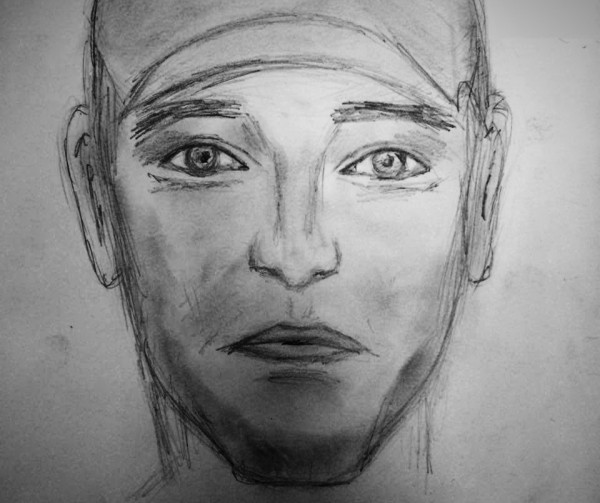
In any case, Kateryna’s friends are not convinced that the police will be able to conduct an effective investigation. They have independently constructed a photorobot of the suspec, and announced a 100,000 UAH ($3,688) prize for information that can help find the attacker (materials should be sent to [email protected]).
Read also:
- Ukraine’s photogenic “new cops” went viral, but the real police reform is yet to start
- Ukraine's fired policemen protest police reform
- Ukrainian Berkut police suspected of Euromaidan massacre now in Russia’s service?
- Unpunished for Maidan pacification, Berkut militia becomes Ukraine’s New Police
- The top-5 unfulfilled demands of Ukraine’s Euromaidan revolution

